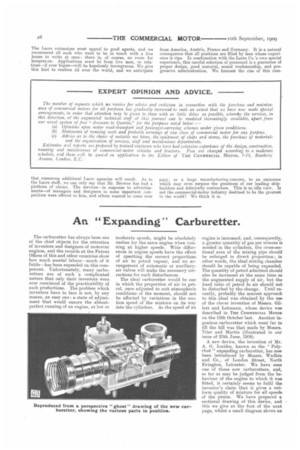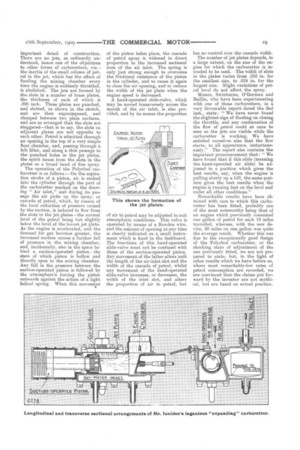An " Expanding " Carburetter.
Page 6

Page 7

If you've noticed an error in this article please click here to report it so we can fix it.
The carburetter has always been one of the chief objects for the attention of inventors and designers of motorcar engines, and the records at the Patent Offices of this and other countries show how much mental labour—much of it futile—has been expended on this component. Unfortunately, many carburetters are of such a complicated nature that only their inventors were ever convinced of the practicability of such productions. The problem which inventors have to face is not, by any means, an easy one: a state of adjustment that would ensure the almostperfect running of an engine, at low or
moderate speeds, might be absolutely useless for the same engine when running at higher speeds. Wide differences in engine speeds have the effect of apsetting the correct proportions of air to petrol vapour, and no arrangement of automatic or auxiliaryair valves will make the necessary corrections for such disturbances_
The ideal carburetter would be one in which the proportion of air to petrol, once adjusted to suit atmospheric conditions of the moment, should not be affected by variations in the suction speed of the mixture on its way into the cylinders. As the speed of an engine is increased, and, consequently, a greater quantity of gas per minute is needed in the cylinders, the cross-sectional area of the mixing pipe should be enlarged in direct proportion; in other words, the ideal mixing chamber should be capable of being expanded. The quantity of petrol admitted should also be increased at the same time as the augmented supply of air, but the fixed ratio of petrol to air should not be disturbed by the change. Until recently, probably the nearest approach to this ideal was obtained by the use of the clever invention of Messrs. Gillett and Lehmann, whose device was described in THE COMMRRCIAL MOTOR on the 15th October last. Another ingenious carburetter which went far to fill the bill was that made by Messrs. Trier and Martin (illustrated in our issue of 25th June, 1908).
A new device, the invention of Mr. A. G. Ionides, known as the " Polyrhoe " expanding carburetter, has now been introduced by Messrs. Wadkin and Co., of London Street, North Evington, Leicester_ We have seen one of these new carburetters, and, so far as may be judged from the behaviour of the engine to which it was fitted, it certainly seems to fulfil the inventor's claim that it gives a uniform quality of mixture for all speeds of the piston. We have prepared a sectional drawing of this device, and this we give at the foot of the next iage, whilst a small diagram shows an
important detail of construction. There are no jets, as ordinarily understood, hence one of the objections to other forms of carburetters, viz.: the inertia of the small column of petrol in the jet, which has the effect of flooding the mixing chamber every time the engine is suddenly throttled, is abolished. The jets are formed by the slots in a number of brass plates, the thickness of each of which is .006 inch. These plates are punched, and slotted, as shown in the sketch, and are then superimposed, and clamped between two plain surfaces, and are so arranged that the slots are staggered—that is to say, the slots on adjacent plates are not opposite to each other. Petrol is admitted through an opening in the top of a very simple float chamber, and, passing through a felt filter, and along a thin passage to the punched holes in the jet plates, the spirit issues from the slots in the plates as a broad band of fine spray. The operation of the PoIyrho carburetter is as follows :—On the aspiration stroke of a piston, air is sucked into the cylinder through the port of the carburetter marked on the drawing "Air inlet," and during its passage the air picks up the spray, or cascade of petrol, which, by reason of the local reduction of pressure caused by the suction, is induced to flow from the slots in the jet plates—the normal level of the petrol being but slightly below the level of the lowest jet plate. As the engine is accelerated, and the demand for gas becomes greater, the increased suction causes a further fall of pressure in the mixing chamber, and, incidentally, also in the space behind a suction-operated piston—the stem of which piston is hollow and directly open to the mixing chamber. Any fall in the pressure between the suction-operated piston is followed by the atmosphere's forcing the piston outwards against the action of a light helical spring. When this movement
of the piston takes place, the cascade of petrol spray is widened in direct proportion to the increased sectional area of the air inlet. The spring is only just strong enough to overcome the frictional resistance of the piston in the cylinder, and to cause it again to close the air opening, and to reduce the width of the jet plate when the engine speed is decreased.
A hand-operated slide-valve, which may be moved transversely across the mouth of the air inlet, is also provided, and by its means the proportion
of air to petrol may be adjusted to suit atmospheric conditions. This valve is operated by means of a Bowden wire, and the amount of opening at any time 19 clearly indicated on a small instrument which is fixed to the dashboard. The functions of this hand-operated slide-valve must not be confused with those of the suction-operated piston. Any movement of the latter alters both the length of the air-inlet slot and the width of the cascade of petrol, whilst any movement of the hand-operated slide-valve increases, or decreases, the width of the inlet slot, and alters the proportion of air to petrol, but
has no control over the cascade width.
The number of jet plates depends, to a large extent, on the size of the engine for which the carburetter is intended to be used. The width of slots in the plates varies from .016 in. for the smallest size, to .018 in. for the largest size. Slight variations of petrol level do not affect the spray.
Messrs. Swinburne, O'Gorman and Baillie, who have been experimenting with one of these carburetters, in a very favourable report dated the 2nd inst., state: "We have never found the slightest sign of flooding on closing the throttle, and any continuation of the flow of petrol could at once be seen as the jets are visible while the carburetter is working. We have satisfied ourselves also that the flow starts, to all appearance, instantaneously." The report also contains the important pronouncement that: "We have found that if this slide (meaning the hand-operated air slide) be adjusted to a position which gives the best results, say, when the engine is pulling slowly up a hill, the same position gives the best results when the engine is running fast on the level and under all other conditions."
Remarkable results have been obtained with cars to which this carburetter has been fitted, probably one of the most noteworthy being that of an engine which previously consumed one gallon of petrol for each 12 miles travelled, whereas, with the new device, 26 miles on one gallon was quite the average result. Whether this was due to the exceptionally good design of the Polyrhoe carburetter, or the shocking state of adjustment of the one previously fitted, we are not prepared to state, but, in the light of other results which we have before us, where most remarkably-low rates r,f petrol consumption are recorded, we are convinced that the claims put forward by the inventor are not mythical. but are based on actual practice.




















